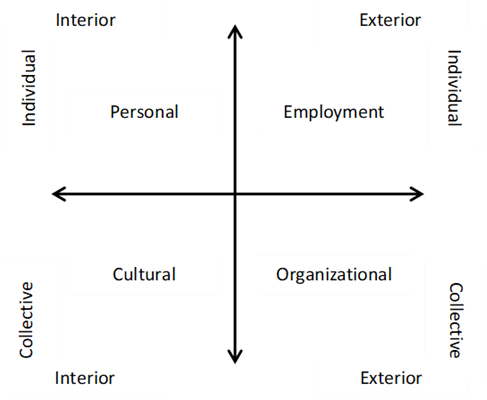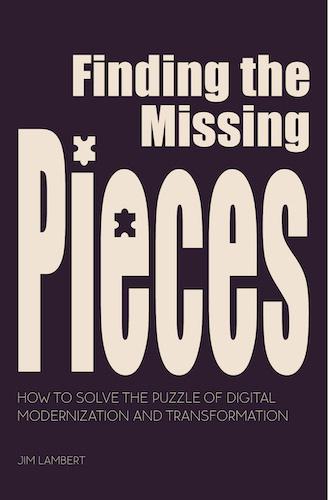Blog July 13, 2021
Missing Pieces: The People, Process & Technology Fallacy


In 2019 the Harvard Business Review reported an estimated $1.3 trillion was spent on digital transformation initiatives. However, most of that money, around $900 billion, was wasted because 70% of those companies failed to achieve their digital transformation goals. The International Data Corporation predicts that global spending on the necessary technologies and services for digital transformation will reach $2.3 trillion by 2023, which, at the current trend, means over $1 trillion could be thrown in the garbage. Over the last several years, there have been thousands of reviews, research efforts, books, blogs, and articles that all sought to understand and explain this continuing trend of failure and waste. Many provided recommendations on how to make digital modernization and transformation initiatives successful, but the rate of failure has not changed. Clearly there are pieces missing from this puzzle.
Most of the thinking over the last several years has been guided by the mantra of ‘People, Process, and Technology’ (PPT) – the thought being that if you address these three areas then your program will be successful. There have been great insights into how many initiatives tend to skew in favor of one or two of these three aspects or speak to the importance of one of them over the others, yet none have shown consistently positive results. Much of the research and punditry has centered around how to leverage specific new technologies or which new processes companies need to implement, and the associated need to train their people in both of those areas. One of the main shortcomings of this is that everyone continues to see people as mere ‘labor hours’ or ‘resources’ for their companies to use as they will to get what they want done. None of them speak to the main obstacle in achieving new levels of organizational maturity: treating these people as the complex human beings they are. The guidance and recommendations in this space all speak to what people DO, but not to who they ARE. The humanity of our organizations has been diminished and reduced to the equivalent of cogs in an outdated machine, when understanding and addressing what people think, feel, and believe is what ultimately clears the path for meaningful and sustained change. There is no transformation without people, and we need to include the evolutionary nature of human beings and their development in our efforts. All of their uniqueness, both individually and in group settings, is a fourth dimension that can be added to the previous three-aspect PPT model. By adding these pieces to the puzzle, we can successfully assemble a picture of the organization’s future.
Gartner’s CEO Survey in 2019 revealed that nearly all CEOs have some digital modernization or transformation effort underway. These CEOs, along with their C-suite colleagues and other senior leaders, want to find a viable way to mitigate the high risk of failure to such large investments. The various external help they bring in as consultants and contractors also want to be the ones to show them the path to success. Yet virtually none of them have a pragmatic model through which they can identify what obstacles they need to overcome and ultimately achieve their digital modernization and transformation objectives. By using the PPT model as a foundation and extending it to include the internal aspects of people in addition to their external aspects, a new approach can be formed.
For this perspective to provide a complete view and representation of the organization being changed, both interior and exterior considerations must be applied at both an individual level and a collective level. The individual level addresses each person both internally and externally, while the collective addresses anything that applies to groups of people such as teams, departments, or the organizational structure and operations overall. As we said before, there is no transformation without people, so it is critical for the ‘interiors’ to be considered just as important as the ‘exteriors.’
It is often stated and understood that in order to be successful you must capture people’s hearts and minds, but it is with much less regularity that an initiative defines how to accomplish that objective as an explicit part of the overall program plan. By taking this perspective – approaching a modernization or transformation initiative with the intent to address both interior and exterior aspects, as well as individual and collective aspects – we have inherently incorporated the ‘hearts and minds’ sentiment. This is the basis for an extended four-aspect thought model, which can be viewed as:
- Personal – the individual interior aspect
- Cultural – the collective interior aspect
- Employment – the individual exterior aspect
- Organizational – the collective exterior aspect
These four aspects can also be diagrammatically depicted as quadrants:

This expanded thought model can be used to visualize a unified and comprehensive modernization or transformation initiative, while emphasizing that there are four contributing aspects that make up such an effort. It can also be utilized as a lens through which to examine both the current state of the company, as well as the image of the future that the initiative is intending to realize. By considering and addressing both the whole and its integral parts, it is more likely that the risk of having an incomplete or biased approach will decrease, while the overall chances for program success will increase accordingly. This is primarily because, when looking at these four aspects, both individually and in total, it provides a framework through which to identify a more comprehensive set of insights regarding where the organization currently stands and where it needs to go. They are the four dimensions of the problem to be solved – the four corners that define the outer boundaries of the puzzle.
This approach is known as the Integral Modernization and Transformation (IMT). It provides a framework to assess the current maturity levels within each quadrant, create a future vision of where the organization wants to modernize and transform, and allows a pragmatic, step-by-step path to emerge. Organizations that have taken this type of holistic approach have consistently been more successful than those simply following the PPT path.

For a more detailed description of the IMT model, its maturity assessment framework, and how to apply it in practice, please read Finding the Missing Pieces: How to Solve the Puzzle of Digital Modernization and Transformation.


